INFORMATION
The Mellotron directly comes from the Chamberlin (see History).
In 1946, in California, Harry Chamberlin created a musical instrument that was able to play pre-recorded magnetic tapes. Somehow, it was the first sampler in history.

Crawdaddy – April 1976
[Thanks to Brian Kehew]
1948 – 1949
Model 100 Rhythmate
Approx. 10 units
It’s the first Chamberlin. It could play 14 drum loops recorded on 1/4″ tapes, with one track on each tape.
This instrument was designed for household purposes.
Taking advantage of the Model 100’s success, Harry Chamberlin started up a shop in Upland, California.
1951 – 1959
Model 200
Approx. 100 units
Unlike the previous model, the 1/4″ tapes of the Model 200 are no longer looped.
There is still only one track per tape, but this is the first Chamberlin to feature a multi-soundbank system.
It is also the first model to have musical instrument sounds (flute, violins, oboe, etc.).
The recordings were made by the Lawrence Welk Orchestra .
Up until 1969, the next Chamberlin models used 3/8″ tapes with 3 tracks per tape.
1960 – 1969
Model 300/350
Approx. 200 units
1961
Model 400
1 unit
1961
Model 500
2 or 3 units
1962 – 1969
Model 600/660 Music Master
Approx. 200 units
The Model 600/660 had two 35 note keyboards: the right hand keyboard was used for lead instruments, while the left hand one was used for rhythmic accompaniments.
Bill Fransen, Chamberlin’s salesman, left for England in 1962 with two Chamberlin 600 Music Masters unbeknownst to Harry Chamberlin.
It is this model that will serve as the basis for the creation of the first Mellotron Mark I, taking up its characteristics with an improved general design.
[See History]
1960 – 1969
25/35/45 Rhythmate
Approx. 100 units
As soon as 1970, Harry Chamberlin gave up the concept of instruments with several sound banks, and created a new series of instruments (800 Riviera, M1, M2, M4), using 1/2″ tapes with 8 tracks per tape, and a stereo playing system. This series was produced from 1970 to 1981.
1970 – 1981
800 Riviera
2 units
M1
Approx. 300 units
The M1 had a 35 note keyboard. It was the most widespread and the most complete model.
M2
5 units
The M2 (or M1D) had a right hand, 35 note keyboard, and a left hand, 25 note keyboard.
M4
4 units
The M4 was basically two M2s in a single cabinet: thus, it had 4 keyboards.
Mike Pinder used a M4 on The Moody Blues’ Seventh Sojourn album.
1975 – 1980
20/30/40 Rhythmate
Patents
Model 100 & 200
- US 2,910,298 – Sound reproducing system
Filed: 07/16/1956 – Issued: 10/27/1959 - US 2,940,351 – Magnetic tape sound reproducing musical instrument
Filed: 10/16/1953 – Issued: 06/14/1960
Music Master
- US 3,250,847 – Musical instrument with record type tone generator
Filed: 07/05/1960 – Issued: 05/10/1966 - US 3,272,907 – Electrical musical instrument having pre-recorded tape for tone generation
Filed: 02/03/1964 – Issued: 09/13/1966
Rhythmate
- US 3,278,188 – Multi-tape reproducer with single pickup head
Filed: 09/03/1963 – Issued: 10/11/1966
M Serie
- US 3,567,840 – Tape drive mechanism for electrical musical instruments
Filed: 06/20/1968 – Issued: 03/02/1971
PHOTOS
- Chamberlin Rhythmate 20 #415
- Chamberlin Rhythmate 35 #692
- Chamberlin Rhythmate 40 #1462
- Chamberlin Model 200
- Chamberlin Model 300 #6413
- Chamberlin Music Master 600
- Chamberlin M1 #86132
- Chamberlin M1R #81304
- Chamberlin M2 #70104
- Chamberlin M4 Riviera 800 #69609
- Chamberlin M4 Riviera 800
- Chamberlin M4
Chamberlin Rhythmate 20 #415











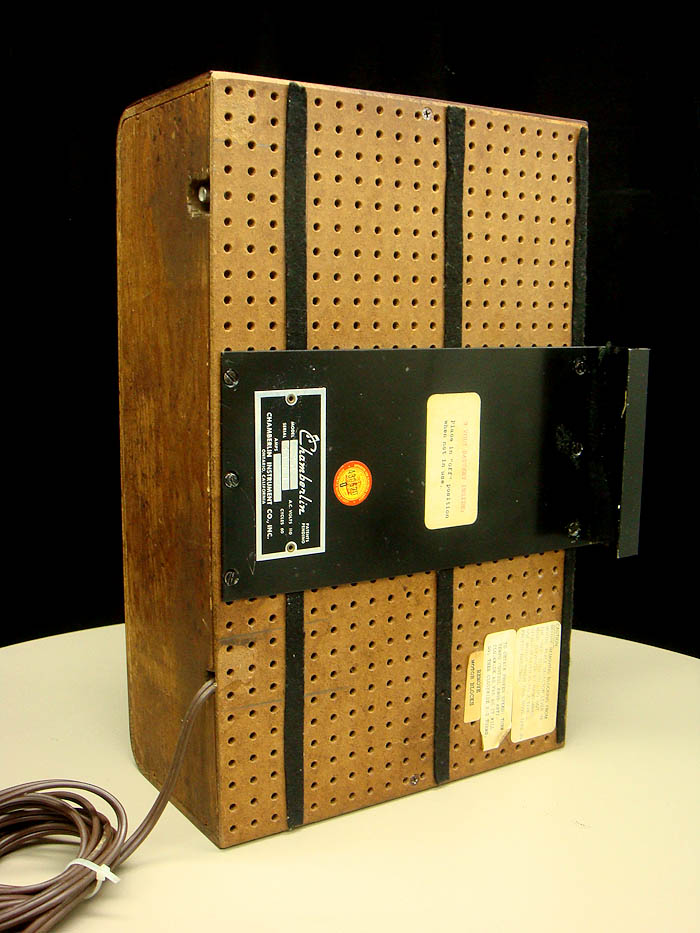




Chamberlin Rhythmate 35 #692






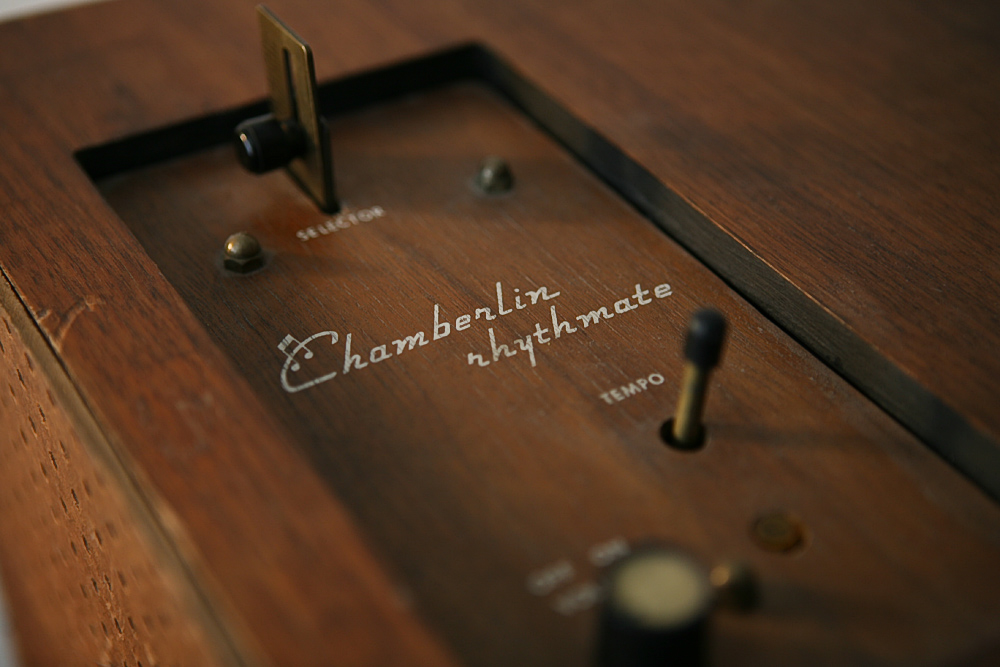







Chamberlin Rhythmate 40 #1462
















Chamberlin Model 200





Chamberlin Model 300 #6413
















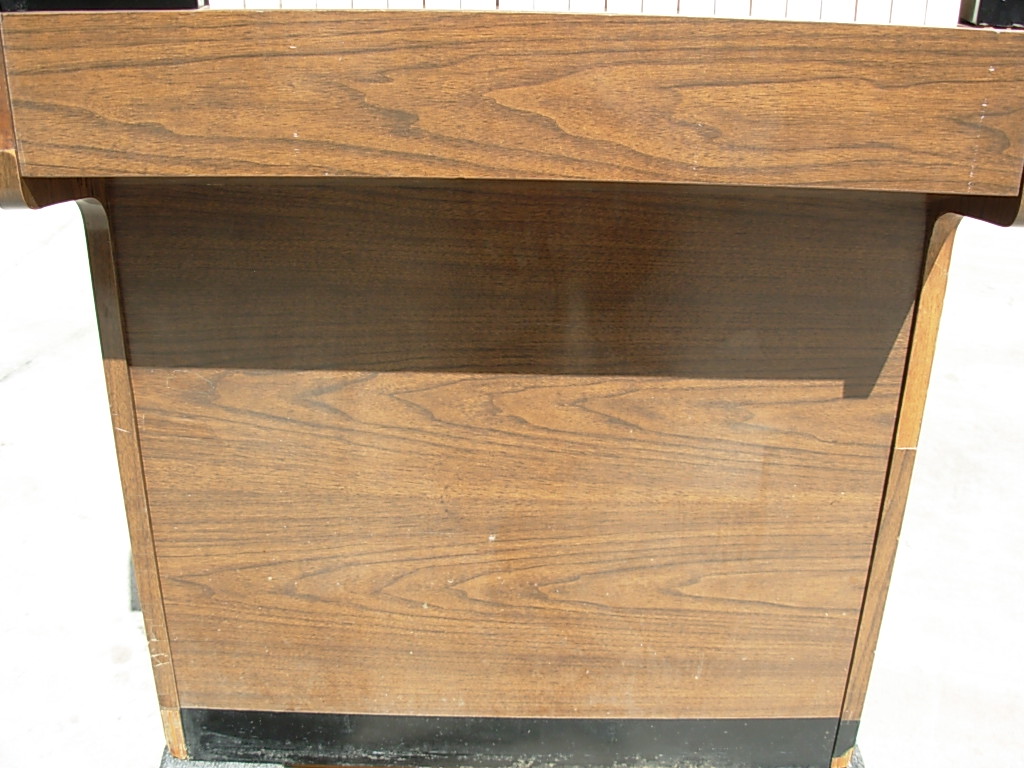













Chamberlin Music Master 600









Chamberlin M1 #86132























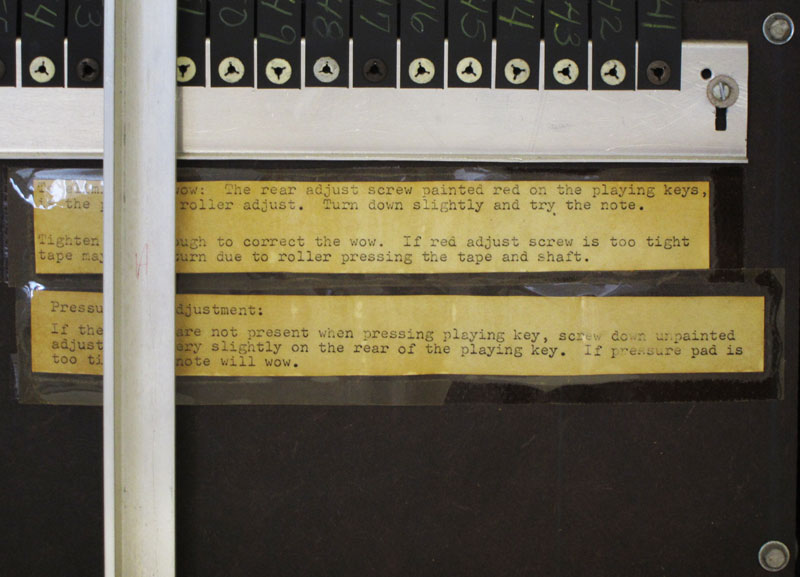

















Chamberlin M1R #81304

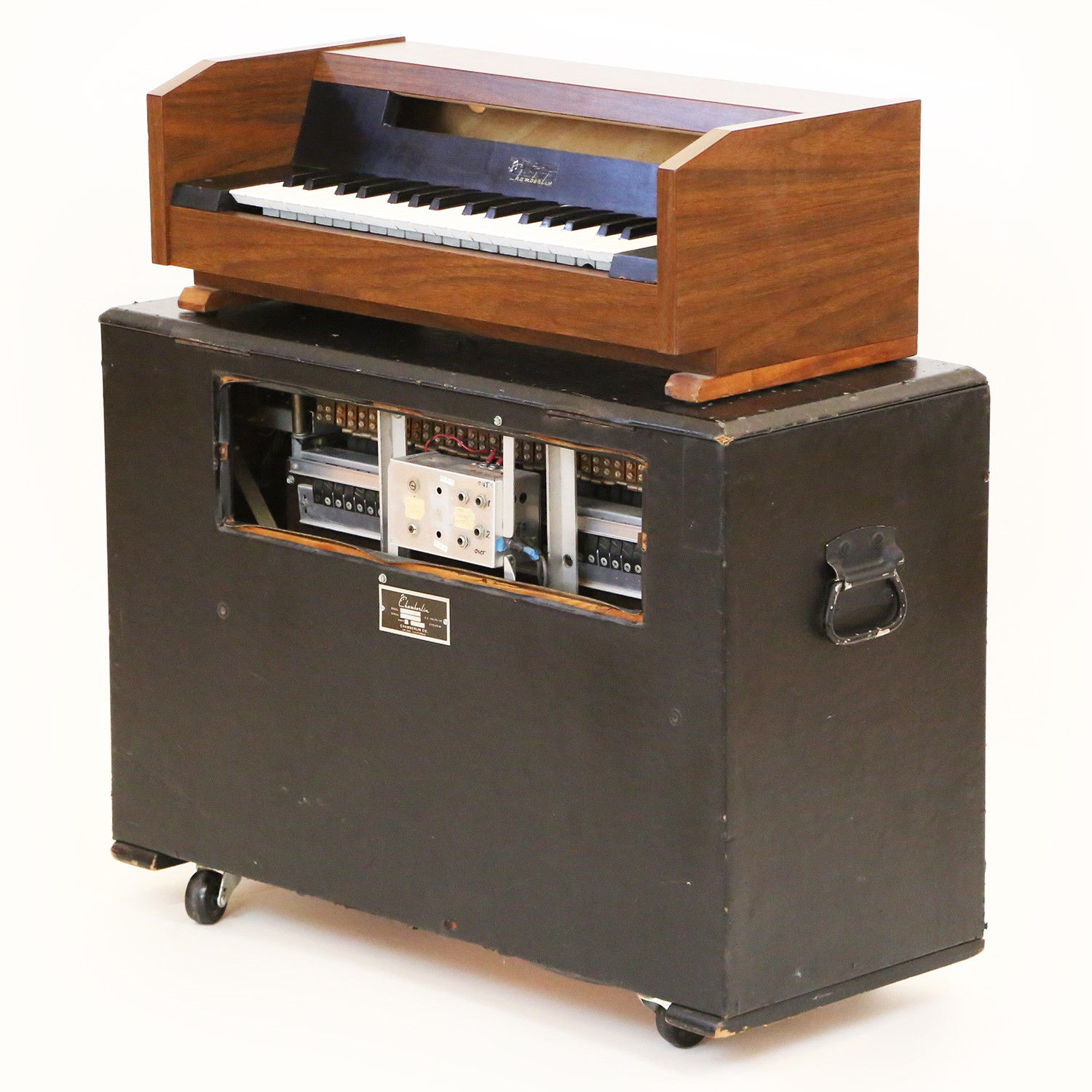





















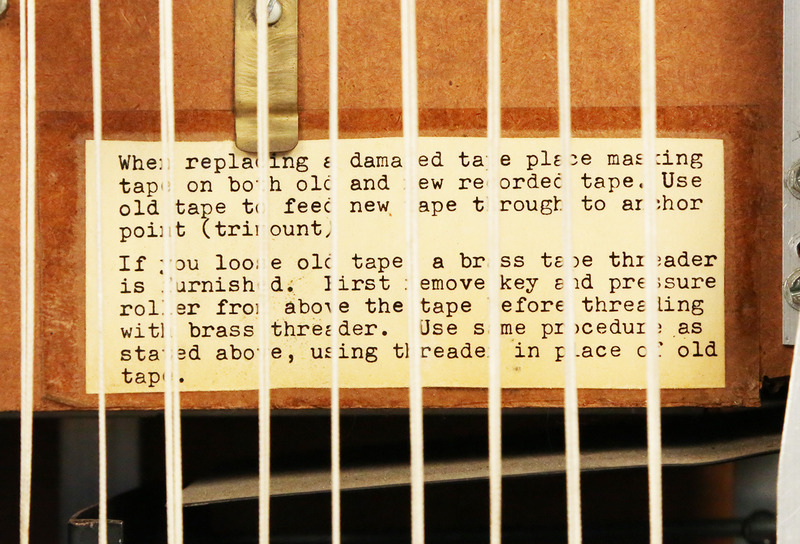
Chamberlin M2 #70104


















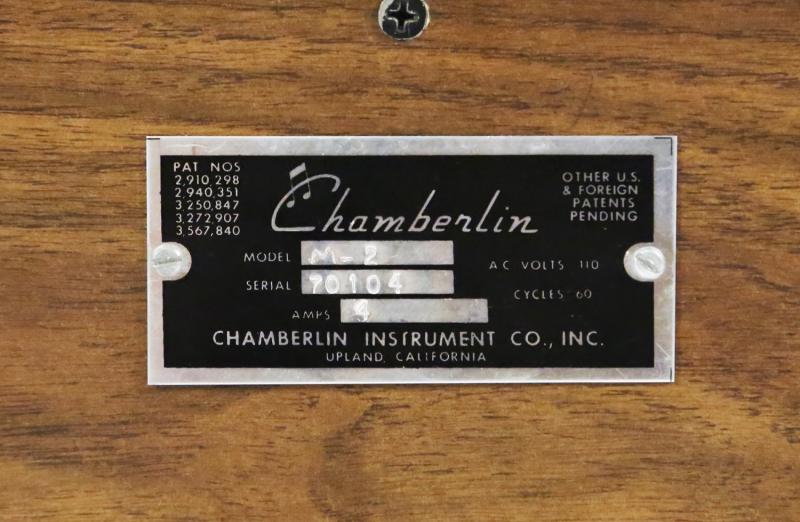




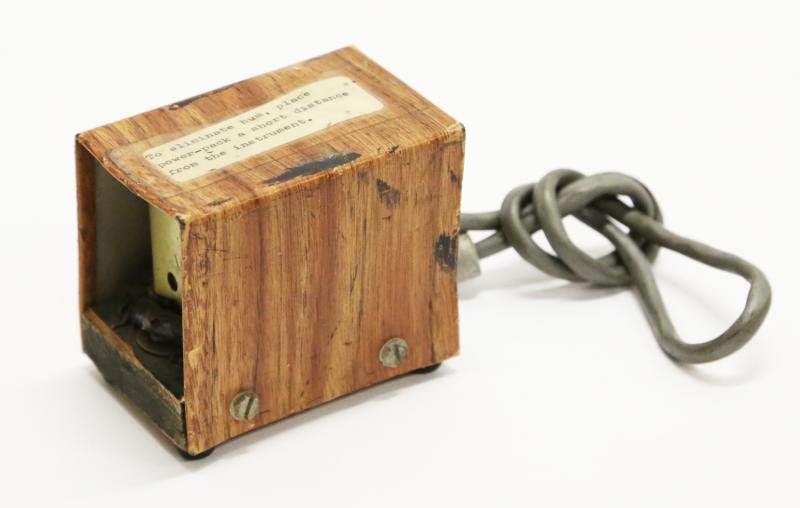






























Chamberlin M4 Riviera 800 #69609
Photos: Don Kennedy for Studio Bell – National Music Center












Chamberlin M4 Riviera 800
Photos: David Cilia

















Chamberlin M4
Photos: GForce Software


VIDEOS

AUDIO
A curiosity to listen to
Two albums by Edmond S. Bordeaux & Norma Jean Nilsson, recorded almost exclusively with Chamberlin in 1965:
SOUND LIST
The sounds of the Chamberlin (especially those of the M1, M2, M4 series) were more realistic and “truer” than those of the Mellotron. This was due to different preamps, and tape heads of better quality. However, the sound alterations caused by the Mellotron’s low fidelity paradoxically gave it more charm, and were the source of typical and immediately recognizable sounds.
The recordings were produced and supervised by Lawrence Welk in Harry Chamberlin’s house. The only sound that the Chamberlin and the Mellotron had in common was the famous “3 Violins”, that was created in 1952 for the Chamberlin, and that you could find in 1964’s Mellotron Mark II.
AVAILABLE SOUNDS AT MELLOTRON ARCHIVES
| KEYBOARDS | BRASS | WIND | PLUCKED |
|---|---|---|---|
| Marimba | Alto Sax | Flute | Slur Guitar |
| Piano | Tenor Sax | Bassoon | Banjo |
| Vibes (w/vibrato) | Trombone | Oboe | Steel Guitar |
| Bells (Glockenspiel) | Trumpet | Bass Clarinet | Harp solo |
| Organ | French Horn | Guitar | |
| Tibia Organ | Do Wah | Mandolin | |
| Kinura Organ | Slur Trombone | ||
| Harpischord | Muted Trumpet | ||
| Electric Harpsichord | |||
| Flute/String Organ |
| VOICE | STRINGS | EFFECTS | PERCUSSION |
|---|---|---|---|
| Male Voice (solo) | 3 Violins | Dixieland Band Phrases | Temple Blocks |
| Female Voice (solo) | Cello | Trombone Sound Effects | |
| Pizzicato Violins |




